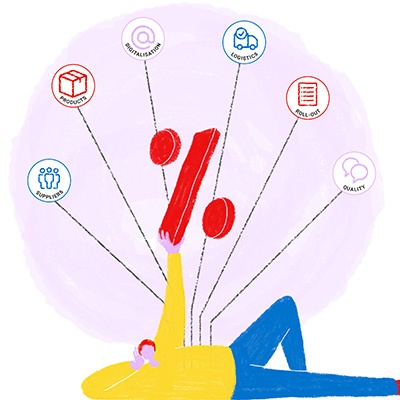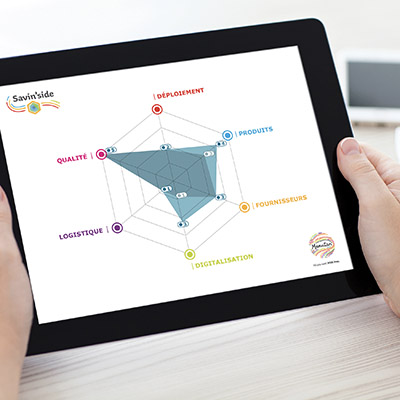In today’s fiercely competitive business environment, companies must continuously enhance operational efficiency, reduce costs, and improve overall quality. Lean Management provides a robust framework to achieve these goals and foster continuous improvement. With its focus on principles and practical tools, Lean Management enables businesses to streamline workflows, eliminate waste, and address root causes of inefficiencies effectively in order to elevate performance and satisfy customer demand.
The importance of Lean Management
Lean Management refers to a work organisation and management approach designed to enhance business performance. This method focuses on process optimisation to reduce non-value-added time, complexity, and causes of poor quality. The term "Lean", derived from the Toyota production system, comes from a Japanese word meaning "without superfluity", perfectly encapsulating its core philosophy: Returning to the essentials by eliminating unnecessary tasks and waste products.
In Lean Management philosophy, waste (“Muda” in Japanese) is hidden in actions that provide no added value for the customer. Examples include overstocking, downtime, inefficient task allocation, and order errors. Effective bottleneck analysis and root cause analysis are essential techniques used to identify the slowest parts of the process and stop these inefficiencies.
Regardless of the tools used, the idea behind the Lean methodology is to allow organisations to improve productivity and efficiency while optimising resource use. As a result, it has a profound impact on customer satisfaction and employee success.
This concept now applies to various key business functions. It is evident in production through Lean Manufacturing, as well as in procurement with Lean Procurement or Lean Purchasing.
What are the four essential lean tools?
Lean Purchasing involves buying less by minimising waste and buying smarter by optimising processes. To achieve this, businesses can utilise a variety of tools, from Value Stream Mapping (VSM) to Kaizen.
Value Stream Mapping (VSM)
Value Stream Mapping (VSM) involves creating a clear map of the value chain, providing both a broad overview and a detailed understanding of procurement processes. The goal is to analyse the various flows, identify waste, and optimise operations.
This visual tool is fundamental to process mapping. It requires defining the specific process to be analysed and determining the key objectives. The work involves collecting the necessary data by engaging with the relevant teams, examining documentation, and observing activities on-site. This ensures each step of the process is documented accurately, reflecting the operational reality and bringing improvement opportunities to light.
The Lean Six Sigma method
Combining Lean principles with Six Sigma strategies, the Lean Six Sigma method aims to improve process quality and efficiency. This approach involves eliminating waste and reducing variations and defects through a systematic methodology. Implemented as a project-based initiative, it relies on a pragmatic problem-solving process called DMAIC.
It consists of five main stages:
- Define: The process begins with identifying the problem and setting the objectives to be achieved. It also involves defining the scope, timeline, and project team.
- Measure: To assess the issue’s scale, the project team uses key indicators, such as service levels or the percentage of off-contract purchases.
- Analyse: The team investigates the root causes of the problem by analysing processes and data.
- Improve: Solutions are tested and then implemented over the long term to address the root causes and solve the problem effectively.
- Control: Results are monitored through the establishment of a tracking and control system to ensure sustained improvements.
The 5S method
The 5S method is a Lean Manufacturing tool that aims to optimise the work environment while reducing waste. It ensures a clean, organised, and well-maintained workspace. The result? Teams are more effective and productive, enjoying an improved peace of mind.
This methodology is built on five key steps:
- Seiri (Sort): The first step involves decluttering the workspace by removing unnecessary or redundant items.
- Seiton (Set in Order): Focuses on organising the workspace to ensure that each team member can quickly and easily access their tools and resources.
- Seiso (Shine): This step is dedicated to cleaning and maintaining the workspace to promote employee well-being, health, and safety.
- Seiketsu (Standardise): Establishes standard procedures to sustain the improvements achieved in the previous steps. These standards help maintain an orderly environment.
- Shitsuke (Sustain): Ensures adherence to these new rules by fostering a culture of continuous improvement across teams.
Throughout the implementation process, teams engage in gemba walks, which involve observing developments, gathering on-the-ground feedback, and identifying additional opportunities for improvement.
The Kaizen method
The Kaizen method is focused on continuously improving processes through collaborative efforts. This approach involves gradual, incremental changes that have a lasting impact on productivity and cost reduction.
As Grace Lagneau, Supply Chain Manager at Lennox EMEA, and Romaric Servajean-Hilst, Professor at Kedge Business School, entrepreneur, and associate researcher, explain: “To be a Kaizen buyer means constantly analysing your portfolio, market, and suppliers. It’s about reflecting, questioning your own practices and those of your internal clients and suppliers, proposing innovative methods, and experimenting with stakeholders.”
To implement a Kaizen project, companies can rely on the PDCA cycle:
- Plan: Conduct a comprehensive analysis of the current situation. This involves mapping all activities, identifying bottlenecks, and planning the next steps.
- Do: The team rolls out the action plan on the ground, focusing on small, successive changes.
- Check: Results are evaluated against predefined performance indicators. This step often involves engaging with teams on the ground to formalise and oversee corrective actions.
- Act: The final stage involves fully deploying the project by integrating the improvements into regular practices.
Ultimately, Lean Management provides a wide range of tools to optimise processes, reduce waste, and enhance customer satisfaction. By adopting the right tools, businesses can strengthen their competitiveness while fostering a more agile and efficient work environment. This approach is a true management philosophy dedicated to performance excellence and effectiveness.









